January
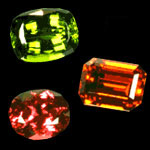
Garnet - The Nightmare Protector
Garnet is the accepted birthstone for the month of January. It is also the accepted anniversary gemstone for the second year of marriage. When most people think of garnet, they picture the dark red bohemian garnet that was popular in Victorian times. You may be surprised to learn that garnets are found in every color except blue, including brilliant green tsavorite garnet, raspberry pink rhodolite garnet, and orange malaya garnet. Bright red "anthill" garnets are found in Arizona. The Tzars of Russia favored rare green damantoid garnets. Garnets offer enough variety in appearance to suit every taste, as well as an outstanding price range to suit every pocketbook. Legend holds that Noah hung a large garnet in the ark for illumination. It reportedly also gives its wearer guidance in the night, protection from nightmares, and according to the Egyptians, is an antidote for snake bites and food poisoning. It was also thought to have a special affinity with the blood. Garnets are durable and brilliant and will give years of pleasure. As with all gemstones, care should be taken to protect it from scratches, sharp blows, and extreme temperature changes. Garnets are found in the U.S., Africa, Sri Lanka, Brazil and India.
February
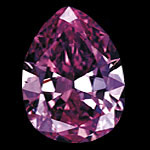
Amethyst - The Intoxication Preventer
Amethyst is the recognized birthstone for February and the accepted anniversary gemstone for the sixth year of marriage. Amethyst is a variety of quartz, and comes in pale lilac to rich, deep purple shades. Ideally, it is a deep medium purple with rose-colored flashes that give amethyst its beauty and fire. Because of its abundance, it is readily available in all sizes and shapes. It is durable and can be worn every day. Coupled with the folk legend of the Greeks that it will prevent intoxication when worn, it becomes a most desirable gem! Amethyst was said to have a sobering effect on the wearer-not only those who indulged but on those over-excited by love's passion as well. It has symbolized peace, protection and tranquility. Some say it will prevent baldness and improve the complexion, as well as protect from treason and deceit. Because royalty has always adored the color purple, amethysts abound in the ornaments of ancient Greeks and Egyptians, and in the British Crown Jewels. As with all gemstones, care should be taken to protect it from scratches and sharp blows. It is found mainly in Brazil, Uruguay and Zambia.
March
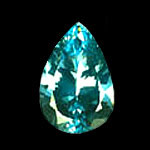
Aquamarine - The Seafarers' Aid
Aquamarine is the traditional birthstone for March. It is also the accepted anniversary gem for the 19th year of marriage. The ideal color of aquamarine is a refreshing pastel sea blue. Stones with a clear blue color without green or gray are generally the most valuable. If you are looking for a big, durable gemstone, aqua is readily available in larger sizes and is truly dramatic when cut in rectangular or oval shapes. It is a member of the important beryl family, which also includes emerald. In ancient times, the stone was said to aid seafarers; thus it is an excellent gift suggestion for sailors or one who takes frequent cruises! To dream of aquamarine signifies the making of new friends; to wear aquamarine earrings brings love and affection. It is a universal symbol of youth, hope and health. As part of the normal finishing process, some aquamarines are heated to remove traces of yellow. To maintain the brilliance of this beautiful gemstone, it should be immersed in jewelry cleaner or in lukewarm soapy water and cleaned with a small bristle brush. Do not use a home ultrasonic machine. As with all gemstones, care should be taken to protect it from scratches and sharp blows. Aquamarine is found mainly in Brazil, Nigeria, Zambia, Madagascar and Ukraine.
April
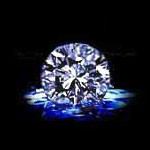
Diamond - A Girl's best friend
Diamond is the birthstone for the month of April. Besides being the most popular gemstone for engagement rings, diamond is the accepted anniversary gem for the 10th and 60th years of marriage. The name "diamond" comes from the Greek word "adamas" meaning unconquerable-suggesting the eternity of love. In fact, diamonds have been the traditional symbol of love since ancient Greece. Discovered about 2,500 years ago in India, the ancients believed they were splinters from the stars, perhaps crystallized lightening or hardened dew drops. Although diamonds are associated with being a colorless stone, they are occasionally found with a strong, bright color-green, red, pink, blue, canary yellow and amber. These "fancy" colored diamonds are highly-prized. Occasionally, to improve appearance, diamonds are laser-drilled and, sometimes, a foreign substance is used to fill surface cavities or fractures. Diamonds may also be irradiated and/or heated to induce "fancy" colors. Even though it is the most durable of gemstones, care should be taken to protect a diamond from sharp blows. Household chemicals may discolor or damage the mounting. To clean, you may use a jewelry cleaner, lukewarm soapy water and a small bristle brush, soak in a half-and-half solution of cold water and ammonia for 1/2 hour, or use a home ultrasonic machine with its recommended cleaner.
May
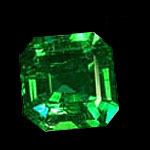
Emerald - Greek for "Green Stone"
Emerald is the birthstone for the month of May. It is also the anniversary gemstone for the 20th and 35th years of marriage. Emerald is one of the most highly-prized of all the gems. The name comes from the Greek "smaragdos" which means green stone. The most prized is pure grass green. Emeralds are often characterized by a garden of included crystals trapped within, known as the "jardin", because under magnification you will see all sorts of lovely patterns resembling foliage in a garden. A flawless, clear emerald is very rare and is usually found in only small sizes. Small to medium sized stones are often faceted in the "step" or emerald cut. The gem is also lovely when cut into a cabochon or dome shape. Sometimes emeralds are even carved. According to legend, the wearing of emerald not only cured a wide range of ailments, including low I.Q., poor eyesight and infertility, but also enabled the wearer to predict the future. As part of the normal fashioning process, most emeralds are immersed in colorless oil or resin so small voids are not as noticeable. Care should be taken to protect it from scratches, sharp blows, household chemicals, and extreme temperature changes. Do not use a home ultrasonic machine. Emeralds are found mainly in Colombia, Brazil, Zambia and Zimbabwe.
June
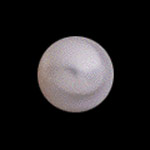
Pearl - The "Treasure of the sea"
Pearl is the birthstone for the month of June. It is also the accepted anniversary gemstone for the 3rd and 30th years of marriage. A pearl is the product of an oyster's defense mechanism. When a foreign irritant is introduced either by man (cultured) or naturally, the oyster immediately surrounds it with layers of a substance called nacre. This forms the exquisite gemstone know as pearl. Pearls come in a wide range of colors. They should be relatively free from skin blemishes. The more perfectly round the shape the better. The higher the luster, or "orient", the more valuable the specimen. The larger the pearl, the greater the value. Besides the popular round shape, there are stylish mabe (large hemispherical cultured pearls), fresh water (elongated in interesting shapes and colors), and South Sea (large cultured pearls 10mm and up from Australia's and Indonesia's waters), to name a few. Pearls have been recognized as the emblem of modesty, chastity and purity. They have come to symbolize a happy marriage. Avoid household chemicals, cosmetics, hair sprays, and perfumes. Don't use ultrasonic cleaners. Wash with mild soap and water and store in a protective chamois pouch or tissue paper. Moonstone is sometimes used as an alternative by those born in June since it physically resembles some pearls.
July
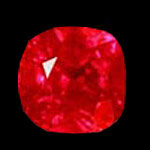
Ruby - the "Lord of the Gems"
Ruby is the accepted birthstone for July. It is also the accepted anniversary gemstone for the 15th and 40th year. Ruby is known as the "Lord of the Gems" because of its rarity and beauty. Derived from the Latin word "ruber", it simply means red. Ruby, like sapphire, is a variety of corundum and only exists as a true red in color. The finest color is a vivid, almost pure spectral red with a very faint undertone of blue, as seen in Burmese rubies which are considered the finest. The highest quality rubies are said to protect their owners from all kinds of misfortune. A fine ruby assured the owner he would live in harmony with his neighbors. It would protect his stature in life, his home and land. Its protective powers were intensified when set in jewelry, and worn on the left side. Many believed rubies possessed an inner flame which burned eternally. As part of the customary fashioning process, virtually all rubies are heated to permanently improve their color and appearance. As with all gemstones, care should be taken to protect it from scratches and sharp blows. The finest rubies emanate from Burma, having been mined there since ancient times. Other sources include Thailand, Vietnam, Sri Lanka, Kenya, Tanzania, Cambodia, Afghanistan and India.
August
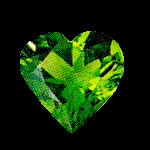
Peridot - The Child of Volcanic Action
Peridot is the accepted birthstone for August. It is also the accepted anniversary gemstone for the 16th year of marriage. Peridot should be a lively lime green, without a brownish or olive cast. Peridot is the child of volcanic action. Tiny peridot crystals are sometimes combed from the black sands of Hawaii. Peridots were favored by pirates, considered powerful amulets against all evil, and when set in gold, were said to protect the wearer from the terrors of the night. They had medicinal uses, too. If fashioned into a chalice from which medicines were drunk, they intensified the effects of the drug. Care should be taken to protect peridot from scratches, sharp blows, household chemicals and extreme temperature changes. Do not use a home ultrasonic machine for cleaning. The peridot is abundant, and is available in larger sizes. It is found in Burma and the U.S. The most important source of peridot in the world is the San Carlos Apache Indian Reservation near Globe, Arizona, where it is mined by native Americans. Large sizes are mined in Myanmar (Burma) and peridot is also found in China.
September
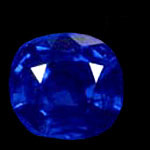
Sapphire - The Teller of the Future
apphire is the September birthstone as well as the accepted anniversary gem for the 5th and 45th years of marriage. Sapphire, a variety of corundum, comes in all colors except red (the red variety being known as ruby), but is especially popular in deep blue. Fancy colored sapphires-including pink, green, orange, and golden yellow-are magnificent when combined in a necklace or bracelet. Prince Charles chose a blue sapphire for Princess Diana's engagement ring. The stone's durability, combined with its beauty, makes it the perfect alternative for an engagement ring. Ancient priests and sorcerers honored sapphire above all gems, for this stone enabled them to interpret oracles and foretell the future. Ancients believed the Ten Commandments were written on a sapphire tablet. Marriage partners put great faith in the stone. If its luster dimmed, one knew his or her spouse had been unfaithful. Sapphire refused to shine when worn by the wicked or impure. As part of the customary fashioning process, virtually all blue, yellow and golden sapphires are heated to permanently produce or intensify their color. As with all gemstones, care should be taken to protect it from scratches and sharp blows. Sapphire is found in Sri Lanka, Thailand, Cambodia, Myanmar (Burma), Kasmir, Australia, Nigeria, Kenya, Tanzania, China and the U.S.
October
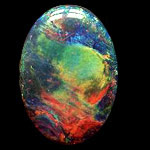
Opal - Hope and innocence
Opal is the October birthstone as well as the accepted anniversary gemstone for the 14th year of marriage. The well-known Roman naturalist Pliny described opal as "made up of the glories of the most precious gems... the gentler fire of the ruby, the rich purple of the amethyst, the sea-green of the emerald, glittering together..." White opal has a white or light body color with flashes of many colors. Black opal has a black, dark blue, dark green or gray body color with vivid flashes of color such as red, pink and bright green. Opal has symbolized hope, innocence and purity through the ages. In the Middle Ages, young, fair-haired girls wore opals in their hair to protect its lovely blond color. Medieval writers believed opal could render its wearer invisible when the need arose. It was also said to have a beneficial effect on eyesight. It was thought to banish evil spirits and favor children, the theater, amusements, friendships and feelings. Care should be taken to protect it from scratches, sharp blows, household chemicals, and extreme temperature changes. To maintain the brilliance of opal, it should be wiped clean with a soft cloth. Do not use a home ultrasonic machine or jewelry cleaner. Opal sources are Australia, Mexico and the U.S. Sometimes tourmaline is used as a birthstone for October and spans the spectrum from red to violet. It also occurs in color combinations in one stone which accounts for its popularity. It is not as fragile as opal and is sometimes selected by those who prefer faceted stones.
November
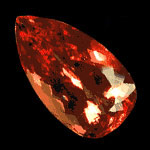
Topaz - Greek for "to shine"
Topaz is the accepted birthstone for November. Blue topaz is the accepted anniversary gemstone for the 4th year; Imperial topaz for the 23rd year of marriage. Most people think of topaz as a transparent golden yellow gemstone. However, this gemstone occurs colorless as well as orange-yellow, red, honey-brown (dark sherry), light green, blue and pink. The name topaz is derived from the Greek word meaning "to shine" and also implies "fire". Orange-red "Imperial" topaz and pink colors are rare and most valuable. The lore, magic and romance of topaz goes back many thousands of years. It holds the distinction of being the gemstone with the widest range of curative powers. The Greeks felt it gave them strength. In addition, it supposedly cooled tempers, restored sanity, cured asthma, relieved insomnia and even warded off sudden death. Topaz is said to make its wearer invisible in time of emergency. It proved the loyalty of associates by changing color in the presence of poison. As part of the normal fashioning process, most brownish to sherry brown topaz are heated to produce a permanent pink color. Certain types of topaz are irradiated and heated to produce shades of blue. Topaz is found mainly in Brazil, Nigeria, Sri Lanka, Pakistan and China. Citrine is often used an alternative to topaz because it appears in many of the same colors as topaz. Unlike topaz, citrine is readily available and inexpensive even in large sizes.
December
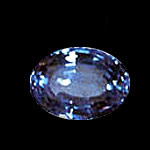
Blue Zircon - Arabic for "vermilion"
Although the name zircon comes from the Arabic "zargoon' meaning vermilion or golden colored, zircons also occur in a wide range of subtle greens and browns and are occasionally colorless. Such stones have been used for many centuries in Indian and Sinhalese jewelry. In western jewelry zircons are most familiar as lustrous and fiery vivid blue, golden or colorless stones which are usually cut as round brilliants. These colors are produced artificially by heating brown zircon from Thailand, Kampuchea and Vietnam. Heating in an oxygen-free atmosphere produces blue zircon, which may then be heating in air to give the golden color. Both processes produce some colorless material. Heat-induced colors sometimes fade on exposure to light but may be restored by careful reheating. Zircon resembles diamond in its fine lustre and fire, so that colorless stones have been both mistakenly identified as diamonds and purposely used as diamond stimulants. Zircon is easily distinguished by signs of wear and double refraction. Although zircon is moderately hard it can be very brittle, and the facet edges of cut stones are easily chipped in wear. It is also strongly doubly refractive, the facet edges appearing doubled when viewed through the stone. Zircon contains traces of uranium or thorium which produce a distinctive absorption spectrum. Radiation from these elements may gradually disrupt and transform the tetragonal crystalline structure to a "metamict" state. Such zircons are usually green and cloudy, show only slight double refraction, and have lower refractive indices, density and hardness.


